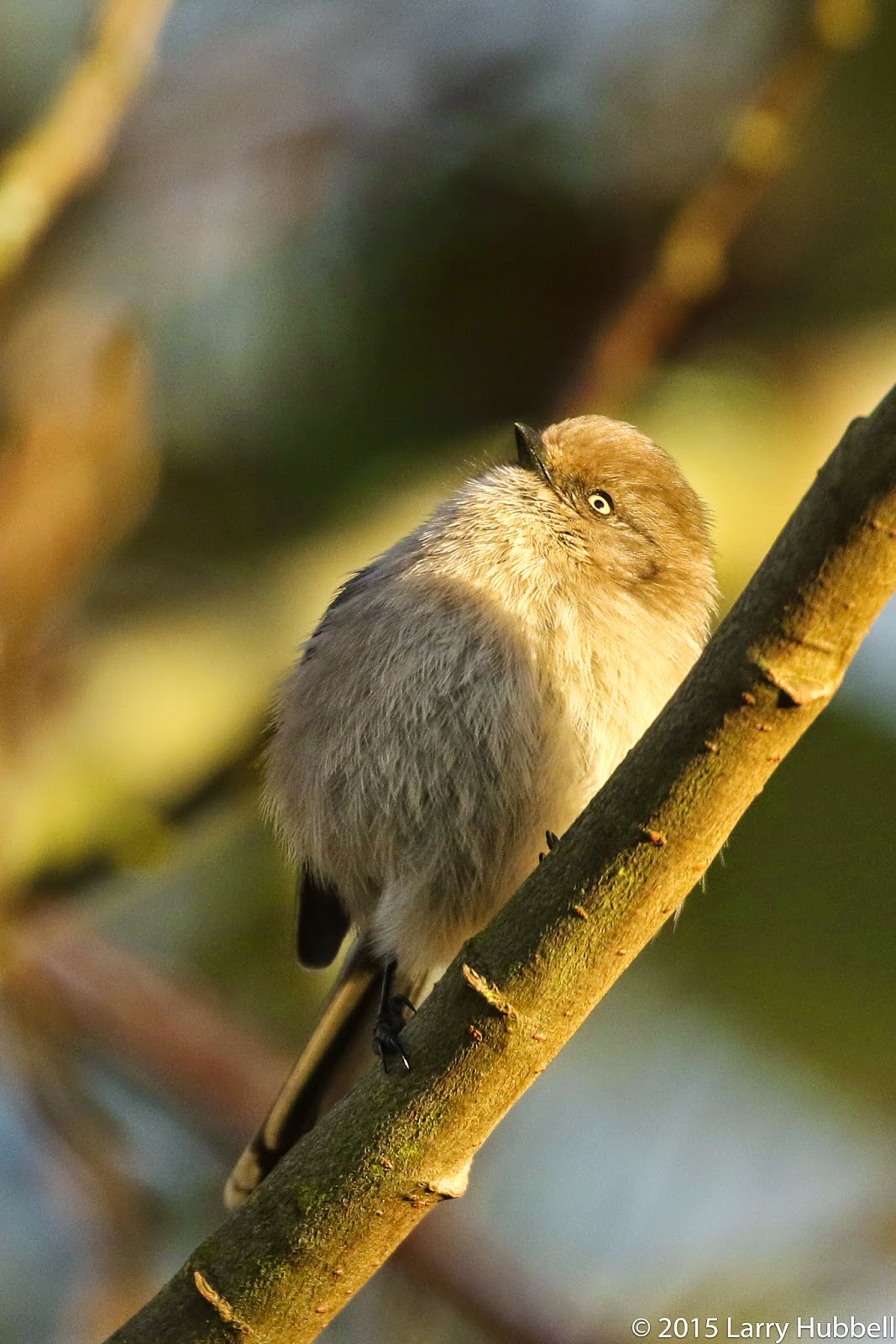With their nearly constant movement, bushtits do not dwell much at all. On the other hand, if we think of 'dwell on' as "having the ability to focus," then bushtits have exceptional concentration.
They are constantly twisting & turning and…
...flittering & fluttering from one twig to the next, while they focus on finding their next mouthful of food. Bushtits weigh less than a quarter of an ounce. While I have no scientific proof, I would not be surprised if they eat their weight in insects every day.
Last week, at the Union Bay Natural Area, a flock of bushtits appeared just before sunset.
The cold wind blowing off the bay ruffled some of her little downy feathers. These very fine feathers look more like hairs, to me.
Only their wing and tail feathers look like "typical" bird feathers. The bushtits swooped in as a cloud of gnats enveloped the willow trees, south of the main pond. As he sits in the sun, this little bird seems to sense the gnat below the twig.
The bushtit appears to listen intently for the buzzing of the gnat's wings. It was surprising the gnat did not fly away.
Once the gnat stops moving, the bushtit loses interest and moves on. Did you happen to notice which of the birds were male or female? If you do not know how to distinguish their gender, the pronouns used above are clues.
Just like human males, hoping for a mating opportunity, a bushtit must keep up his appearance.
All the extra cleaning…
...can be time consuming.
However, when you think...
…you may fall head-over-heels for someone, the time spent can be worth the investment.
In fact, this tiny pair appears to be mating, while sharing a branch with another pair of bushtits. (Although, despite the appearances, the male might be moving from the outer position on the branch in search of the additional warmth available in between the other birds.)
Afterwords, the female moves towards the warmth of the setting sun, while the male seeks warmth from the next bird on the branch. I wonder if the mating implies they have already built a nest nearby.
You can see for yourself by following this link: My Joyous Winter Project
I would love to have bushtits nesting near my house. I never thought about all the materials they need to build their nests. It appears they use spider's silk, lichen, moss and various small, lightweight pieces of plants. Easily available materials should improve the odds of them nesting in my yard. In the future, I will think twice about what things "need" to be cleaned up.
By the way, did you know, you may be able to bring native plants into your yard and get a rebate for the cost? The plants would have to be part of a rain garden. It is an idea worth exploring. If you are interested, you can learn more about the rain garden program via SustainableBallard.
You can read more about bushtits and their nests on BirdWeb and All About Birds.
Have a great day on Union Bay…where nature lives in the city!
Larry
FYI:
The female bushtit has a yellow iris and a dark pupil.
The pupil and iris of a male bushtit are both dark.

















Your photography of the Bushtits is simply divine and the lighting is beautiful. My gosh, you even photographed a gnat in the first image! Thank you so much for sharing the images and for your kind words about Craig and Joy and me.
ReplyDeleteThank you. Your post has me almost hoping it rains next week, so I will stay inside and build bird boxes.
DeleteSomeday, I hope to get to watch a bushtit nest in action. Craig's video work is incredibly exquisite! Thank you to all three of you for the inspiration!
Fantastic photography, and LOVE the story line just as much. Thank you for sharing. I have watched many Bushtits enjoying their extended family and have even had the pleasure of watching I bet for at least an hour, weaving their sock nest. Incredible to say the least.
ReplyDeleteSammy
Sammy,
ReplyDeleteThank you for your kind words and for sharing your special encounter with the bushtits. Maybe some day I will be lucky enough to see the same process. Thanks again!
Larry
Wonderful! We have watched them build their nest only to tear it down & move it a few feet if they see you staring at them. As soon as their babies fledge, they tear the nest down that same day.
ReplyDeleteThank you! I have never heard about them taking a nest down after the young fledge. It is very interesting! I wonder, what is the advantage of that behavior? Very curious!
Delete